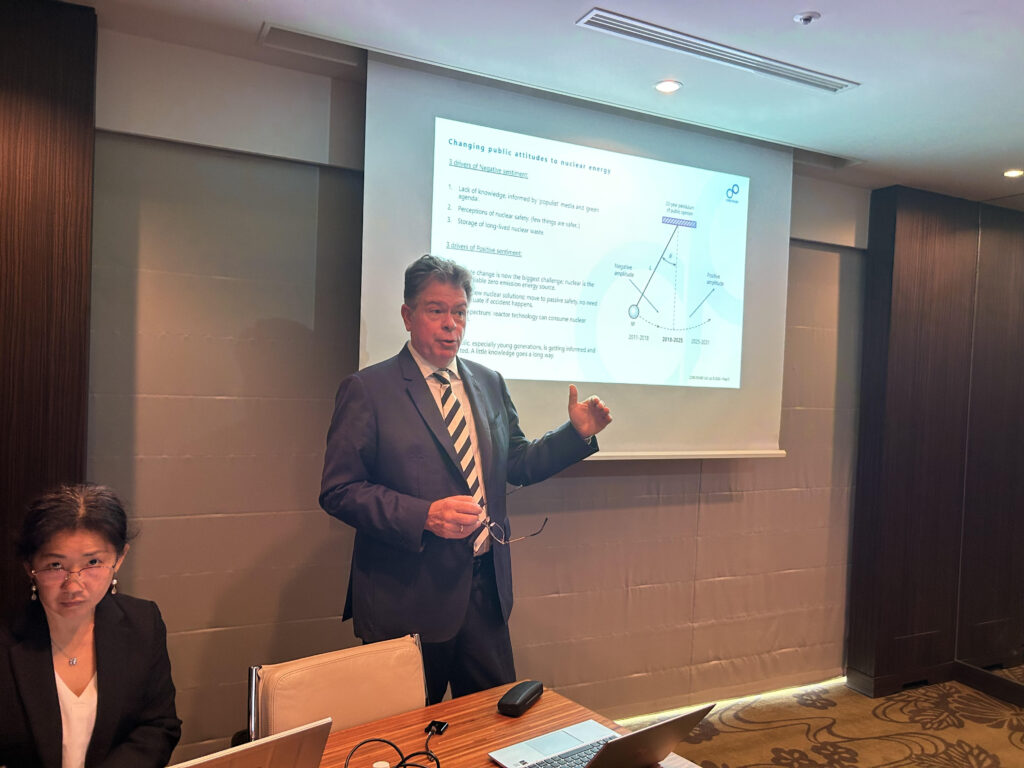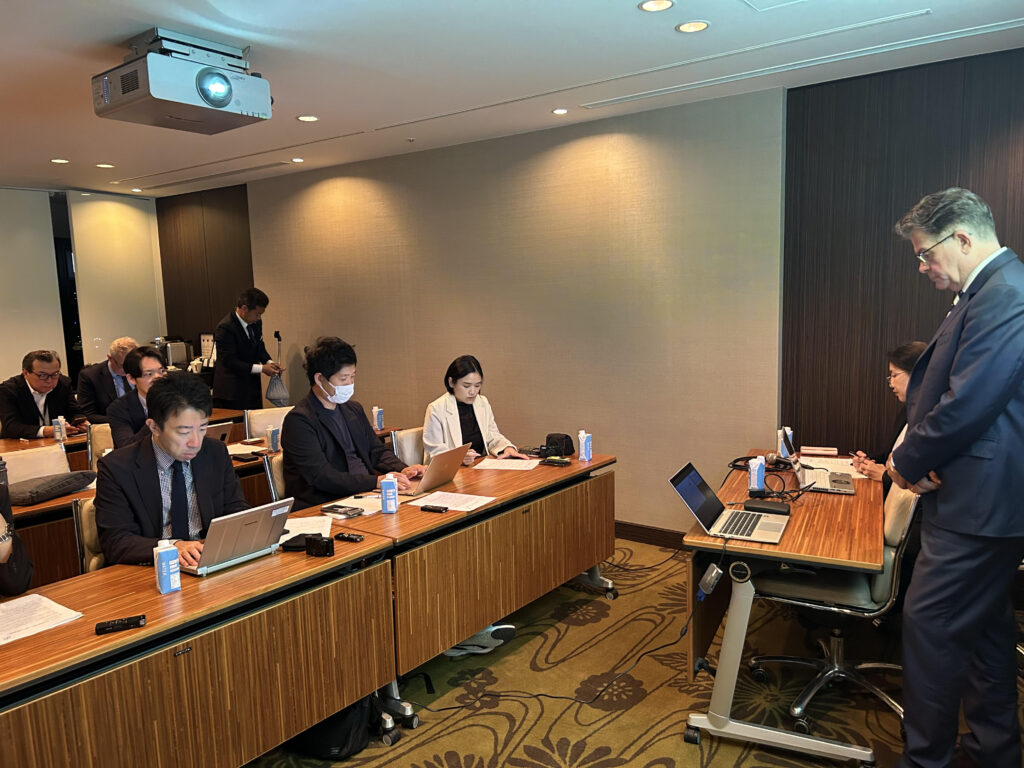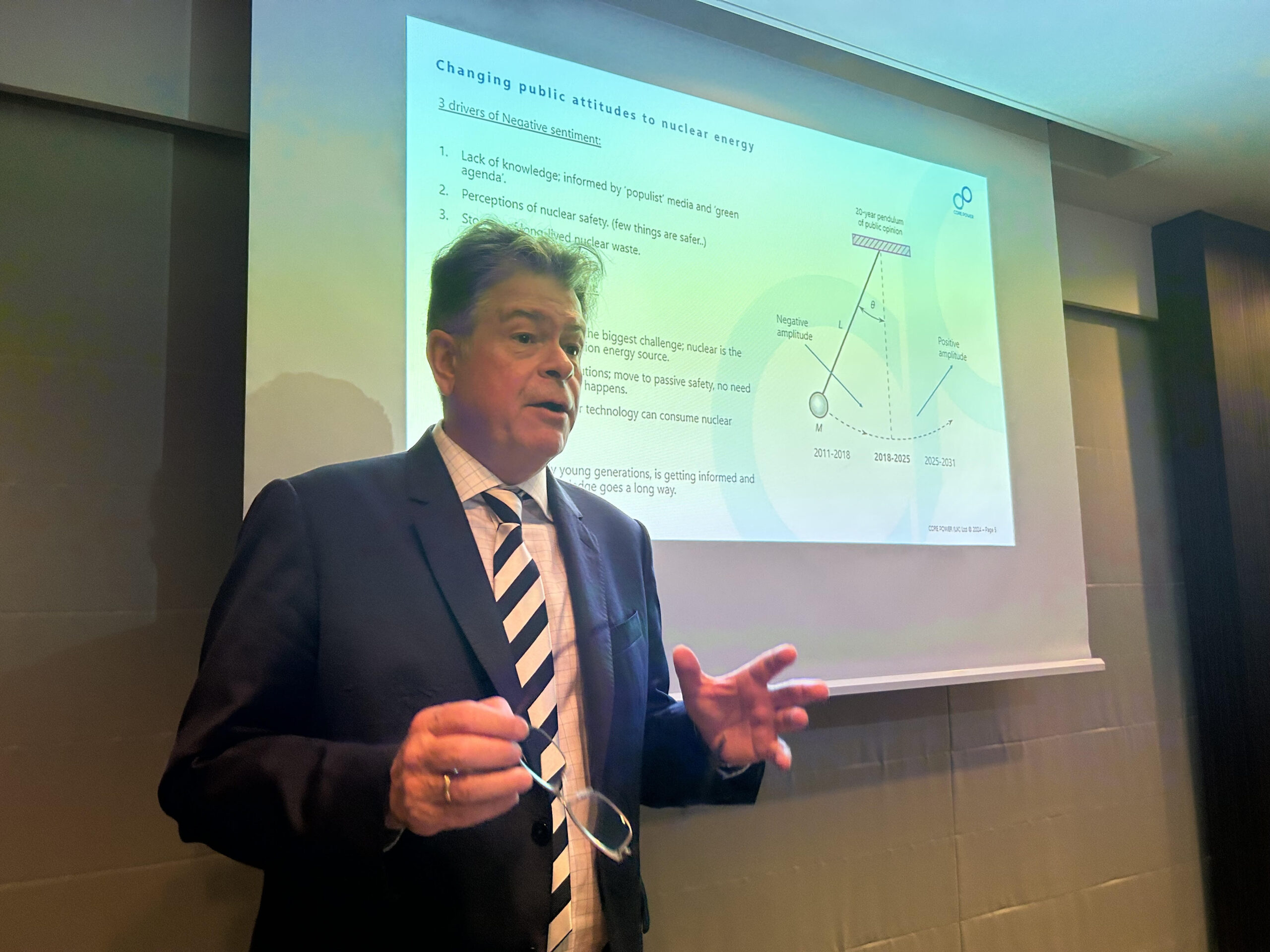London-based CORE POWER, a pioneer in integrating next-generation nuclear reactors into marine propulsion and floating nuclear power plants, announced on October 16th that it has secured $500 million (approximately 74.5 billion yen) in funding to support technology development and program construction. Speaking at a press conference in Tokyo, Chairman and CEO Mikal Bøe highlighted the significant role Japanese companies play, currently holding a 26% share in the company. CORE POWER aims to generate orders worth $10 billion by 2030, with the realization of nuclear-powered marine engines and floating nuclear plants set between 2030 and 2035.
(Text by Hiro Yamamoto)
(Photo courtesy of CORE POWER, JMD)

Founded in 2018, CORE POWER has successfully closed its Series B funding round with this latest financing milestone. With 65 shareholders worldwide, the company is also exploring the potential for a future public listing.
CEO Bøe emphasized the broad potential of advanced reactors, stating, “These reactors can not only serve as propulsion systems for large vessels but also power floating nuclear plants to meet the growing electricity demands of data centers and other infrastructure.” CORE POWER is actively participating in the development of the Molten Chloride Fast Reactor (MCFR) project, a next-generation nuclear reactor.
Bøe outlined three key criteria essential for success in the marine sector:
1. Low Pressure
2. Long Fuel Cycle
3. Passive Safety – minimizing the impact on humans and the environment in case of malfunctions.
He contrasted these advanced reactors with traditional light-water reactors (LWRs), which operate under high pressure and require extensive Emergency Planning Zones (EPZ) due to accident risks. According to Bøe, the MCFR’s low-pressure design significantly reduces the EPZ requirements, making it easier to obtain commercial insurance coverage. Industry groups, including the Nuclear Energy Maritime Agency, are actively working on developing insurance frameworks for these reactors, with the goal of establishing viable policies by 2030.

■Technology Companies and Future Prospects
On October 14th, Google announced a contract with U.S.-based nuclear startup Kairos Power to purchase energy from seven small modular reactors (SMRs) developed by the company. These reactors will supply power to Google’s data centers. Google has been actively accelerating clean energy solutions for over a decade, including advanced technologies, through renewable energy procurement agreements. The company stated that this agreement not only ensures a clean and reliable energy supply but also helps accelerate the development of technologies that can maximize the potential of artificial intelligence.
CORE POWER’s focus on utilizing next-generation reactors to meet the power demands of data centers aligns with these strategies pursued by major U.S. tech companies.
■Partnership with the Insurance Industry and Development of International Standards
Securing insurance coverage for the MCFR (Molten Chloride Fast Reactor) will be a critical step for CORE POWER. CEO Mikal Bøe highlighted the challenges of traditional light-water reactors (LWRs), noting that they operate under high pressure and require extensive Emergency Planning Zones (EPZs) due to accident risks, making commercial insurance unfeasible. In contrast, the MCFR’s low-pressure design minimizes EPZ requirements, increasing the feasibility of obtaining insurance coverage.
Industry groups, including the Nuclear Energy Maritime Agency, are currently working to develop insurance frameworks for the MCFR. Bøe elaborated on the significance of insurance in a global regulatory context:
“The International Maritime Organization (IMO) is revising its safety standards for nuclear-powered vessels, filling gaps related to nuclear safety, security, and safeguards in the marine environment. This work involves both the IMO and the International Atomic Energy Agency (IAEA), with technical work planned from 2025 through 2028. A comprehensive framework should be in place by 2030, involving key insurance players like P&I clubs and nuclear risk insurers.”
Bøe expressed confidence in the timeline:
“By 2030, it will be possible to ensure all nuclear risks under this framework, making it a realistic and well-suited timeline for our program.”
CORE POWER estimates that, by 2060, the market for large vessels powered by advanced nuclear reactors will include 3,000 ships, generating $3 trillion in economic value. The market for floating nuclear power plants is expected to reach 1,500 units, with an estimated value of $2.6 trillion.

■Global Maritime Forum Annual Summit
The Global Maritime Forum (GMF), an international non-profit organization dedicated to advancing global maritime trade, held its annual summit at Happo-en, Tokyo, on October 15th. Arsenio Dominguez, Secretary General of the International Maritime Organization (IMO), participated in a panel discussion alongside Takeshi Hashimoto, President of Mitsui O.S.K. Lines (MOL), and senior representatives from Rio Tinto and the University of Tokyo’s Global Commons Initiative.
When asked by Japan Maritime Daily whether the IMO is prepared to adopt nuclear-powered propulsion, Dominguez responded:
“The answer is yes. The possibility of nuclear propulsion is already part of the Marine Environment Protection Committee’s process. There are many benefits beyond safety—particularly in the variety of energy sources available on ships. We are not ruling out any options.”
Dominguez further commented:
“This is the first time I’ve been asked what kind of fuel will be used, and the answer remains the same: We are technology-agnostic. This transition will offer some countries the opportunity to leverage their domestic renewable resources.”
He emphasized that regulatory processes will not hinder technological development:
“Scalability and regulations are not barriers but enablers for explaining these opportunities. Nuclear energy plays an essential role in our future assessments, including lifecycle evaluations. We are actively investigating all safety aspects within regulatory frameworks.”

■Looking Ahead: CORE POWER’s Global Strategy
CORE POWER will continue collaborating with international organizations such as the OECD, IAEA, and IMO to develop rules and frameworks. The company is advancing toward the commercialization of nuclear-powered vessels and floating nuclear plants after 2030.
〆英コア・パワー(CORE POEWER) 、5億㌦資金調達にめど。日本企業のシェア26%、2030 年以降に次世代型原子炉の船舶エンジン、浮体式原子力発電の具体化を目指す。
船舶推進機関やや浮体式原子力発電へ次世代型原子炉の導入を進める英コア・パワー(本社・ロンドン、CORE POEWER)の会長兼CEO(最高経営責任者)のミカル・ボー(Mikal Bøe)氏は2024年10月16日、東京都内で記者会見を開き、技術開発とプログラム構築に必要な資金として5億㌦(745億円)の資金調達にめどがついたと語った。現在、コア・パワーへの出資に占める日本企業の割合は26%。同社は2030年まで100億㌦規模の受注を進め、2030-2035年に次世代型原子炉を活用した船舶エンジン、浮体式原子力発電の具体化を目指す。
(Text by Hiro Yamamoto)
Photo courtesy= CORE POEWER、JMD
コア・パワーは2018年に設立。今回、「シリーズB」と呼ばれる5億㌦の資金調達にめどをつけた。
コア・パワーは全世界に65の株主を持つ。将来的には株式公開の可能性も探る。
Bøe CEOは、次世代原子炉の活用について「大型船の推進システムだけでなく、データセンターなど電力需要が増加している浮体式原子力発電所への活用も期待できる」と説明した。
コア・パワーが現在、参画している次世代型原子炉は、「溶融塩高速炉」(モルテン・クオライド・ファスト・リアクター、MCFR)と呼ばれるプロジェクト。
BøeCEOは船舶での成功のための三つの評価基準として「『低圧』『長い燃料サイクル』『パッシブセーフティー』(異常事態に人体などへの影響を最小限に抑える技術)を満たす」の3点を指摘した。
その上で、従来の軽水炉(LWR)技術の原子炉の課題については「高圧下で運転され、事故発生時に備えて周囲に大規模な緊急時計画ゾーン(EPZ)が必要なため、商業的に保険をかけることができない」と説明した。
溶融塩炉は低圧で運転され、事故発生時のEPZを最小限に抑えられるため、次世代型原子炉への保険の開発の実現にも期待感を示した。現在、業界団体の原子力エネルギー海事機関が次世代型原子炉への保険について検討しており、30年までに保険の実現に取り組む。
■テクノロジー企業との連携と今後の展望
一方、米Googleは10月14日(現地時間)、自社のデータセンターに電力を供給するため、米原子力新興企業Kairos Powerが開発する7基の小型モジュール炉(SMR)から原子力エネルギーを購入する契約を結んだと発表した。
Googleは、10年以上前に再生可能エネルギー電力の企業購入契約を開始し、次世代の高度なクリーン技術を含むクリーンエネルギーソリューションを加速してきたという。この契約は、エネルギーニーズをクリーンかつ確実に満たし、すべての人にとってAIの潜在能力を最大限に引き出すための新しい技術の加速に役立つとしている。
コア・パワーのデータセンターへの電力需要に対する次世代型原子炉の活用は、こうした米テック企業のコンセプトと合致する。
■保険業界との協力と国際基準の策定
コア・パワーにとっては、MCFRへの保険の付与が今後の試金石となりそうだ。
ボーCEOは従来の軽水炉(LWR)技術の原子炉の課題については「高圧下で運転され、事故発生時に備えて周囲にEPZが必要なため、商業的に保険をかけることができない」と説明した。
MCFRについては軽水炉のような対策が必要でないため、保険の付与の可能性は十分期待できるとしている。
実際、業界団体の原子力エネルギー海事機構では現在、MCFRへの保険の付与について検討している。
ボーCEOはMCFRへの保険について次のように説明する。
「IMO(国際海事機関)は現在、原子力船の安全基準の改定作業を開始している。これは重要なことだ。なぜなら、これは安全に関する基本的な国際基準であり、国際エネルギー機関が改定作業を開始しているためである。実際には、改定ではなく、原子力安全、核セキュリティ、海上環境における核保障措置のギャップを埋める作業である」
「来年、2025年には、IMOとIAEAが協力を開始する。その後、多くの技術的な作業が控えている。25年、26年、27年、28年と技術的な作業を行い、28年、29年、30年にはこの枠組みが整うだろう。並行して、保険業界では、P&Iクラブが参加し、原子力リスク保険会社が集結する。原子力エネルギー海事機構と呼ばれる組織があり、現在、保険に関する作業を行っている。そして、2030年というタイムラインは現実的であり、プログラムにも非常に適していると考えている。なぜなら、2030年までにすべての保険対象を保険可能にできるからだ」
コア・パワーは2060年までに次世代型原子炉を使った大型船市場は3000隻、3兆㌦、浮体式原子力発電の市場規模は1500基、2・6兆㌦に達すると試算している。
■グローバル・マリタイム・フォーラムの年次サミット
一方、世界の海上貿易の発展を目指す国際非営利団体「グローバル・マリタイム・フォーラム」(GMF、本部・デンマーク)の年次サミットが2024年10月15日夕、八芳園(HAPPO-EN、東京都港区)で開幕した。
オープニングイベントには国際海事機関(IMO)のアルセニオ・ドミンゲス(Arsenio Dominguez)事務局長(Secretary General)が商船三井(MOL)社長の橋本剛(Takeshi Hashimoto)、英豪資源大手リオティントのコマーシャルオペレーション責任者、東京大学グローバルコモンズ(Global Commons)担当総長特使らとともにパネルディスカッションに登壇した。
その中で、IMOのアルセニオ・ドミンゲス(Arsenio Dominguez)事務局長(Secretary General)がJapan Maritime Dailyの記者から「IMOは原子力推進機関の導入について準備が出来ているか」と問われ、次のように説明した。
「答えはイエスだ。すでに海洋環境保護委員会のプロセスに、将来の推進手段の可能性の一つとして含まれている。安全面以外にも、原子力から得られるものはたくさんある。船上で使用されるエネルギーの種類がそこにあるからだ。私たちはあらゆる選択肢を排除しているわけではない」
「実際、燃料が何であるかという質問が他者に向けられたのは初めてのことだと思うが、原子力に対する答えは同じです。私たちは、技術に関しては無神論者だと感じている。なぜなら、これは一部の国が機会を捉えて、自国内に大量に存在する再生可能資源に焦点を当てるという移行期になるだろうと、当初から認識しているからだ」
「また、拡張性や規制プロセスは、それらの機会を詳細に説明したり、技術開発を妨げたりするものでもない。ですから、原子力は非常に重要な検討課題となっているのだ。将来の分析のためのライフサイクル評価にも含まれている。ですから、私たちは何も排除せず、常にあらゆる規制プロセスの安全要素を調査している」
COREPOWEERは今後、OECD、IAEA, IMOなど各国際機関と連携、ルール策定などを行い2030年以降の実用化に向け事業を進める方針だ。
